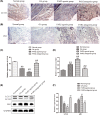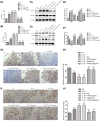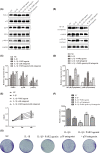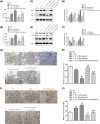Down-regulation of protease-activated receptor 2 ameliorated osteoarthritis in rats through regulation of MAPK/NF-κB signaling pathway in vivo and in vitro
- PMID: 32134473
- PMCID: PMC7098131
- DOI: 10.1042/BSR20192620
Down-regulation of protease-activated receptor 2 ameliorated osteoarthritis in rats through regulation of MAPK/NF-κB signaling pathway in vivo and in vitro
Abstract
Recently, protease-activated receptor 2 (PAR2) has been proved to be involved in the inflammatory response including osteoarthritis (OA). In the present study, we found that PAR2 antagonist could remarkably improve the pathological condition of OA rats in vivo. In addition, we also found that PAR2 antagonist could suppress the production of inflammatory factors (TNF-α and Cox-2), decrease the levels of MMP-1 and MMP-13, and restrain the levels of P62 proteins and aggravate the expression of LC3-II both in vivo and in vitro. Besides, in vitro, PAR2 antagonist could increase the proliferation and colony formation of chondrocytes induced with IL-1β. Moreover, PAR2 antagonist could decrease the expression of expressions of p-p38, p-IκBα and p-NF-κB in vitro. However, PAR2 agonist exhibited the opposite effects. Furthermore, SB203580, a p38 MAPK inhibitor, could remarkably promote the proliferation of chondrocytes induced with IL-1β, could alleviate the production of TNF-α and Cox-2, could down-regulate the protein expressions of MMP-1 and MMP-13, and could decrease the expression of P62 and increase the expressions of LC3-II of chondrocytes induced with IL-1β. Importantly, SB203580 could reverse the effects of PAR2 agonist on the functions of chondrocytes induced with IL-1β. Taken together, the present data suggest that down-regulation of PAR2 can ameliorate OA through inducing autophagy via regulation of MAPK/NF-κB signaling pathway in vivo and in vitro, and PAR2 can be considered as a potential candidate to treat OA.
Keywords: Autophagy; MAPK/NF-kB signaling pathway; Osteoarthritis; Protease-activated receptor 2.
© 2020 The Author(s).
Conflict of interest statement
The authors declare that there are no competing interests associated with the manuscript.
Figures








Similar articles
-
Protease-activated receptor 2 (PAR-2) antagonist AZ3451 as a novel therapeutic agent for osteoarthritis.Aging (Albany NY). 2019 Dec 16;11(24):12532-12545. doi: 10.18632/aging.102586. Epub 2019 Dec 16. Aging (Albany NY). 2019. PMID: 31841119 Free PMC article.
-
Vorinostat, a HDAC inhibitor, showed anti-osteoarthritic activities through inhibition of iNOS and MMP expression, p38 and ERK phosphorylation and blocking NF-κB nuclear translocation.Int Immunopharmacol. 2013 Oct;17(2):329-35. doi: 10.1016/j.intimp.2013.06.027. Epub 2013 Jul 13. Int Immunopharmacol. 2013. PMID: 23856614
-
Effects of mesenchymal stem cells on interleukin-1β-treated chondrocytes and cartilage in a rat osteoarthritic model.Mol Med Rep. 2015 Aug;12(2):1753-60. doi: 10.3892/mmr.2015.3645. Epub 2015 Apr 20. Mol Med Rep. 2015. PMID: 25892273 Free PMC article.
-
Protease-activated receptor 2: A promising therapeutic target for women's cancers.J Pharmacol Exp Ther. 2025 Jan;392(1):100016. doi: 10.1124/jpet.124.002176. Epub 2024 Nov 22. J Pharmacol Exp Ther. 2025. PMID: 39892996 Review.
-
The development of proteinase-activated receptor-2 modulators and the challenges involved.Biochem Soc Trans. 2020 Dec 18;48(6):2525-2537. doi: 10.1042/BST20200191. Biochem Soc Trans. 2020. PMID: 33242065 Free PMC article. Review.
Cited by
-
Mechanism of trypsin-mediated differentiation of pancreatic progenitor cells into functional islet-like clusters.World J Diabetes. 2025 Jun 15;16(6):102727. doi: 10.4239/wjd.v16.i6.102727. World J Diabetes. 2025. PMID: 40548274 Free PMC article.
-
MiR-19b-3p Attenuates Chondrocytes Injury by Inhibiting MAPK/NF-Κb Axis via Targeting SOCS1.Evid Based Complement Alternat Med. 2022 Oct 11;2022:5133754. doi: 10.1155/2022/5133754. eCollection 2022. Evid Based Complement Alternat Med. 2022. Retraction in: Evid Based Complement Alternat Med. 2023 Jun 21;2023:9819124. doi: 10.1155/2023/9819124. PMID: 36267095 Free PMC article. Retracted.
-
Downregulation of Matriptase Inhibits Porphyromonas gingivalis Lipopolysaccharide-Induced Matrix Metalloproteinase-1 and Proinflammatory Cytokines by Suppressing the TLR4/NF-κB Signaling Pathways in Human Gingival Fibroblasts.Biomed Res Int. 2022 Oct 4;2022:3865844. doi: 10.1155/2022/3865844. eCollection 2022. Biomed Res Int. 2022. PMID: 36246974 Free PMC article.
-
PAR2 activation on human tubular epithelial cells engages converging signaling pathways to induce an inflammatory and fibrotic milieu.Front Pharmacol. 2024 Jun 28;15:1382094. doi: 10.3389/fphar.2024.1382094. eCollection 2024. Front Pharmacol. 2024. PMID: 39005931 Free PMC article.
-
The activation fragment of PAR2 is elevated in serum from patients with rheumatoid arthritis and reduced in response to anti-IL6R treatment.Sci Rep. 2021 Dec 20;11(1):24285. doi: 10.1038/s41598-021-03346-0. Sci Rep. 2021. PMID: 34930943 Free PMC article.
References
Publication types
MeSH terms
Substances
LinkOut - more resources
Full Text Sources
Medical
Research Materials

